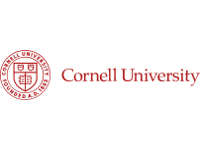PARADIM Highlight #57—External User Project (2022)
Robert Hovden & John Heron (University of Michigan) and collaborators
Charge density waves (CDW) are an emergent periodic modulation of the electron density that permeates crystals with strong electron-lattice coupling. TaS2 and TaSexS2-x host several charge density wave states that spontaneously break crystal symmetries, mediate metal-insulator transitions, and compete with superconductivity. These quantum states are promising candidates for novel devices, efficient ultrafast nonvolatile switching, and suggest elusive chiral superconductivity.

Figure 1: (Left) Twinned, commensurate CDW at room temperature in ultrathin TaS2. (Right) Pristine 1T-TaS2 at room temperature hosts nearly commensurate CDW. Upon heating the incommensurate CDW takes over at ~350 K in a normally reversible transition. Remarkably, heating above ~620 K and subsequent cooling stabilizes the twinned commensurate CDW phase.
Here, PARADIM’s Electron Microscopy Facility enables users to explore a long-range order CDW state in engineered interdigitated polytypes of TaS2. Originally dominated by a conductive nearly commensurate CDW the material transitions to an insulating twinned-commensurate CDW phase as polytype interleaving isolates and decouples monolayers that host commensurate 2D-CDWs. Combining structural and electronic investigations the users show that this new approach suppresses an intermediate non-commensurate phase and pushes the metal-insulator transition to well above room temperature.
To close the loop of their materials discovery the users developed a model to illustrate the pathway for accessing these coherent 2D quantum states through heat treatment of the host crystal, initializing the system to an incommensurate phase that choses either of the commensurate structures when cooled down.
Compelling evidence suggests distinct correlated electron behavior may exist only in clean 2D materials such as 1T-TaS2. Unfortunately, experiment and theory suggest that extrinsic disorder in free standing 2D layers disrupts correlation-driven quantum behavior. Here we demonstrate a route to realizing fragile 2D quantum states through endotaxial polytype engineering of van der Waals materials. The true isolation of 2D charge density waves (CDWs) between metallic layers stabilizes commensurate long-range order and lifts the coupling between neighboring CDW layers to restore mirror symmetries via interlayer CDW twinning. The twinned-commensurate charge density wave (tC-CDW) reported herein has a single metal–insulator phase transition at ~350 K as measured structurally and electronically. Fast in-situ transmission electron microscopy and scanned nanobeam diffraction map the formation of tC-CDWs. This work introduces endotaxial polytype engineering of van der Waals materials to access latent 2D ground states distinct from conventional 2D fabrication.
In summary, the long-range ordered CDW state was stabilized at room-temperature by reducing its dimension to 2D using engineered interdigitated polytypes of TaS2. The metallic layers isolate each 2D CDW to restore twin degeneracy giving rise to an out-of-plane twinned commensurate CDW phase. 4D-STEM mapped twinned CDW order across large fields-of-view (~1 μm) to confirm twin structure and atomic resolution HAADF-STEM revealed the 2D Oc-layers embedded in metallic Pr-layers. Both structural and electronic investigations show that the disordered NC-CDW phase disappears for a 2D CDW in a chemically and epitaxially native environment. The stabilization of the tC-CDW phase illustrates 2D polytype engineering as a new route to exotic correlated electron states.
Exotic correlated electron behavior can exist in 2D materials, however, extrinsic disorder in free standing 2D layers impedes such correlation-drive quantum behavior. Here, PARADIM users demonstrate a new approach to realize clean-limit 2D ground states through polytype engineering of van der Waals materials. In engineered TaS2 heterostructures, they isolate spatially coherent 2D charge density waves (CDW) and raise the metal—insulator phase transition temperature by 150°C to well above room temperature. This discovery provides access to coherent CDWs at room temperature and the associated metal-insulator transition may enable a paradigm shift toward ultrafast low-energy device logic and quantum computing.
PARADIM’s sensitive EMPAD detector enabled mapping of the CDW domain structure across large fields-of-view thereby confirming the discovered commensurate twin structure in the engineered interleaved 2D polytypic heterostructures of TaS2.
The project was enabled through a PARADIM User Proposal submitted by Robert Hovden (University of Michigan) and the user’s group performed the electron microscopy at PARADIM facilities.
Michigan News: “Quantum tech: Semiconductor ‘flipped’ to insulator above room temp” https://news.umich.edu/quantum-tech-semiconductor-flipped-to-insulator-above-room-temp/
S.H. Sung, N. Schnitzer, S. Novakov, I. El Baggari, X. Luo, J. Gim, N. Vu, Z. Li, T. Brintlinger, Y. Sun, P. Deotare, K. Sun, L. Zhao, L.F. Kourkoutis, J.T. Heron, and R. Hovden, “Two-Dimensional Charge Order Stabilized in Clean Polytype Heterostructures,” Nat. Commun.13, 413 (2022). DOI: https://doi.org/10.1038/s41467-021-27947-5
S.H.S. acknowledges the financial support of the W.M. Keck Foundation. L.Z. acknowledges support by NSF CAREER grant No. DMR-174774 and AFOSR YIP grant No. FA9550-21-1-0065. Experiments were conducted using the Michigan Center for Materials Characterization (MC2) with assistance from Haiping Sun and Bobby Kerns and the Platform for the Accelerated Realization, Analysis, and Discovery of Interface Materials (PARADIM) supported by the National Science Foundation under Cooperative Agreement No. DMR-2039380. This work was performed in part at the University of Michigan Lurie Nanofabrication Facility with assistance from Pilar Herrera-Fierro, Vishva Ray, and Sandrine Martin—supported by the National Science Foundation Major Research Instrumentation award under No. DMR-1428226. Y.L., W.J.L., and Y.P.S. thank the support of the National Key Research and Development Program under contracts 2016YFA0300404 and the National Nature Science Foundation of China under contracts 11674326, 11774351. T.H.B. acknowledges support from the Office of Naval Research through the Base Program at the Naval Research Laboratory. P.B.D. acknowledges support of the Army Research Office grant No. W911NF2010196. We thank Lu Li for helpful discussion.







